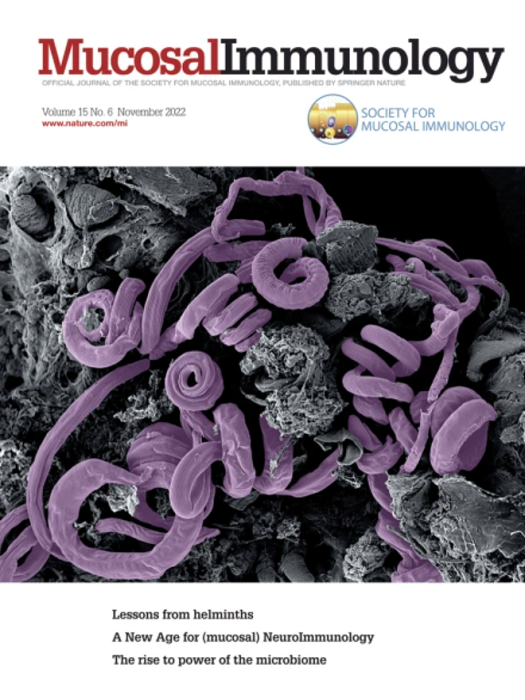Exogenous ephrin-A3 reverses loss of vaginal epithelial barrier protection in progestin-treated mice
IF 7.6
2区 医学
Q1 IMMUNOLOGY
引用次数: 0
Abstract
Desmosomes are junctional complexes that confer mechanical strength and enhance barrier protection at mucosal epithelial surfaces by anchoring intermediate filaments to plasma membrane. These roles are best defined in cutaneous epithelium, but we previously identified lower levels of the desmosomal cadherins desmoglein-1 (DSG1) and desmocollin-1 (DSC1) and loss of barrier function in vaginal epithelium of mice treated systemically with the progestin depot medroxyprogesterone acetate (DMPA). We also showed these changes were avoided in mice treated with both DMPA and a conjugated equine estrogen vaginal cream. We extend these earlier results in the current investigation, identifying ephrin-A3 (EFNA3) as an important regulator of desmosomal cadherin gene expression in murine vaginal epithelial tissue. Moreover, topical treatment of mice with recombinant EFNA3 (rEFNA3) significantly increased vaginal expression of DSG1 and partially reversed the loss of vaginal epithelial barrier function induced by DMPA treatment. Consistent with this improvement in vaginal epithelial barrier protection, mortality caused by genital herpes simplex virus type 2 infection was delayed, but not prevented, in mice administered DMPA and rEFNA3 vs. DMPA alone. Together, current studies identify EFNA3 as a key regulator of desmosomal structure and function in vaginal epithelium and newly suggest that ephrin-Eph signaling pathways will provide an important target for enhancing vaginal epithelial integrity and barrier function.
外源性ephrin-A3逆转孕激素处理小鼠阴道上皮屏障保护的丧失。
桥粒是连接复合物,通过将中间丝锚定在质膜上,赋予粘膜上皮表面机械强度并增强屏障保护。这些作用在皮肤上皮中得到了最好的定义,但我们之前发现,在全身注射黄体酮醋酸甲羟孕酮(DMPA)的小鼠阴道上皮中,桥粒体钙粘蛋白桥粒素-1 (DSG1)和桥粒素-1 (DSC1)的水平较低,屏障功能丧失。我们还发现,在使用DMPA和结合马雌激素阴道乳膏的小鼠中,这些变化是避免的。我们在当前的研究中扩展了这些早期的结果,确定了ephrin-A3 (EFNA3)是小鼠阴道上皮组织中桥粒钙粘蛋白基因表达的重要调节因子。此外,用重组EFNA3 (rEFNA3)局部处理小鼠可显著增加阴道DSG1的表达,并部分逆转DMPA处理引起的阴道上皮屏障功能丧失。与阴道上皮屏障保护的改善相一致,在给予DMPA和rEFNA3的小鼠中,与单独给予DMPA相比,生殖器单纯疱疹病毒2型感染引起的死亡率延迟,但不能预防。总之,目前的研究发现EFNA3是阴道上皮桥胞体结构和功能的关键调节因子,并且新的研究表明ephrin-Eph信号通路将为增强阴道上皮完整性和屏障功能提供重要靶点。
本文章由计算机程序翻译,如有差异,请以英文原文为准。
求助全文
约1分钟内获得全文
求助全文
来源期刊

Mucosal Immunology
医学-免疫学
CiteScore
16.60
自引率
3.80%
发文量
100
审稿时长
12 days
期刊介绍:
Mucosal Immunology, the official publication of the Society of Mucosal Immunology (SMI), serves as a forum for both basic and clinical scientists to discuss immunity and inflammation involving mucosal tissues. It covers gastrointestinal, pulmonary, nasopharyngeal, oral, ocular, and genitourinary immunology through original research articles, scholarly reviews, commentaries, editorials, and letters. The journal gives equal consideration to basic, translational, and clinical studies and also serves as a primary communication channel for the SMI governing board and its members, featuring society news, meeting announcements, policy discussions, and job/training opportunities advertisements.
 求助内容:
求助内容: 应助结果提醒方式:
应助结果提醒方式:


